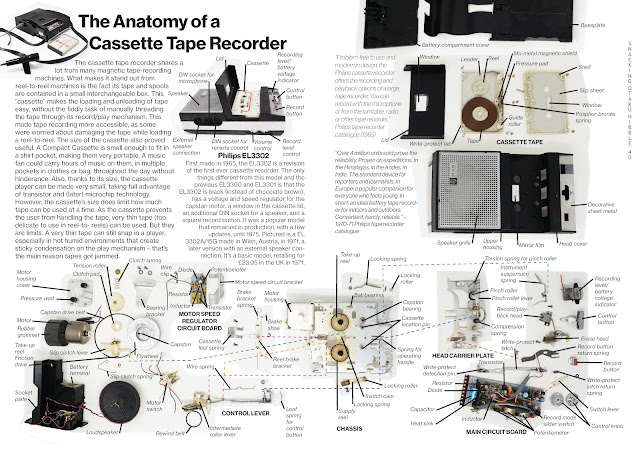References and Further info
vintage-technics.ru/Eng-Philips_EL_3302.htm
www.radiomuseum.org/r/philips_el3302_00_12d_20d_22d_29d.html
www.cassettedeck.org/philips/el_3302
www.classicradioshop.info/philips-cassette-recorders
www.vintage-radio.net/forum/ - History Of Philips EL33XX Series Cassette Recorder
www.45spaces.com/audio-compact-cassette-blank-tapes
The
cassette tape recorder shares a lot from many magnetic tape-recording machines.
What makes it stand out from reel-to-reel machines is the fact its tape and
spools are contained in a small interchangeable box. This “cassette” makes the loading and unloading of tape easy,
without the fiddly task of manually threading the tape through its record/play
mechanism. This made tape recording more accessible, as some were worried about
damaging the tape while loading a reel-to-reel. The size of the cassette also
proved useful. A Compact Cassette is small enough to fit in a shirt pocket,
making them very portable. A music fan could carry hours of music on them, in
multiple pockets in clothes or bag, throughout the day without hinderance.
Also, thanks to its size, the cassette player can be made very small, taking
full advantage of transistor and (later) microchip technology. However, the
cassette’s size does
limit how much tape can be used at a time. As the cassette prevents the user
from handling the tape, very thin tape (too delicate to use in reel-to-reels)
can be used. But they are limits. A very thin tape can still snap in a player,
especially in hot humid environments that create sticky condensation on the
play mechanism – that’s the main reason tapes got jammed.
Philips EL3302
First made
in 1965, the EL3302 is a revision of the first ever cassette recorder. The only
things different from this model and the previous EL3300 and EL3301 is that the
EL3302 is black (instead of chocolate brown), has a voltage and speed regulator
for the capstan motor, a window in the cassette lid, an additional DIN socket
for a speaker, and a square record button. It was a popular model that remained
in production, with a few updates, until 1975. Pictured is a EL 3302A/15G made
in Wien, Austria, in 1971, a later version with an external speaker connection.
It’s a basic model, retailing for £23.05 in the UK in 1971.
“Problem-free to use and modern in design, the Philips
cassette recorder offers the recording and playback options of a large tape
recorder. You can record with the microphone or from the turntable, radio or
other tape recorder,” Philips
tape recorder catalogue (1965)
“Over 4 million units sold prove the reliability. Proven on expeditions. In the Himalayas, in the Andes, in India. The standard device for reporters and journalists. In Europe: a popular companion for everyone who feels young. In short: an ideal battery tape recorder for indoors and outdoors. Convenient, handy, reliable.” – 1970-71 Philips tape recorder catalogue


Comments
Post a Comment